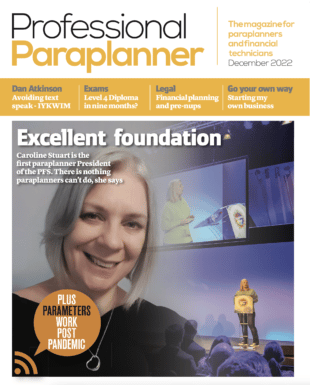Helena Wardle, Partner & Chartered Financial Planner at Smith & Wardle, gives an adviser’s view on suitability reports and how they can bring the focus on clients to life
Despite sterling efforts in some parts of the industry, and paraplanners feature highly here, and some clear guidance from the Regulator, as an industry it seems to me the real purpose of the suitability letters has been lost, as more often then not they have become a compliance tick box exercise, a document to cover firms’ backsides from FOS and something the regulator tells us we have to do. All of these reasons have a begrudging feel to them which in this day and age is, quite frankly, depressing.
Also, I believe that great advice can get hidden in overcomplicated suitability letters – some cynics may add, bad advice can be hidden too. But I think we can flip this on its head and start making suitability letters genuinely client focused across the board.
‘Compliance says’
At times compliance is overruling the hugely important soft stuff that is needed to help demonstrate and create trust with clients. The area where I feel this is most relevant is in suitability letters. I don’t believe this is on purpose but I think that as an industry we misinterpret requirements and at times feel that we need to justify ourselves to prove we have done the right thing.
Past complaint rulings by FOS can also add to hangover statements being added to letters to cover off a point that was missed off or not covered well enough in the past. Multiple times we have been told by the regulator that suitability letters are unclear, too long, complex and need to be more personalised. The guidance on this has been around since 2011 and if you read the findings you can see some of those points crop up again eight years later. The Regulator’s guidance on ‘Assessing Suitability’ is not rocket science and some might say it’s not very prescriptive, but I think that’s the point.
If we focus on the principles that the Regulator is trying to enforce, ‘client’s best interest’ and ‘treating customers fairly’, we are effectively asking our compliance teams to help us enforce these principles. It’s very subjective and can often get looked at from the ‘adviser’ and ‘compliance’ points of view. What about the client?
While we can argue that we are heavily regulated, I also think there is a huge amount of self-regulation required and this is the area on which I want to focus.
Let’s try to look at this from a client’s point of view. How do you prove that you are doing the right thing when no one other than your client is watching?? You will not have every case checked and for the most part clients do not always read suitability letters because they are long and dull. So how do we prove that our advice is suitable for our clients in the document labelled ‘Suitability letter’? How do we make this document more engaging and relevant? How do we help an outsider to the process read the story of the advice we gave to the client? We need to factor in that it is not just FOS or compliance teams that need to understand our advice. Family members might one day, or even at the time of advice, read our suitability letters. Do we reflect our client’s story well enough to convince them that we properly advised their loved ones who they know so well?
I don’t know of any research that has specifically asked for a client’s views of Suitability letters, so I have used research by the consumer website Boring Money entitled ‘Financial communications are broken’ (see reference). If you replace the words ‘fund factsheet’ with the word ‘Suitability letter’ I wouldn’t be surprised if the outcome is the same. If you want to create a truly client focused business, I would recommend following what they are doing as they have a habit of asking consumers the right questions.
Here’s some consumer comments from the study:
“I read the document and I wanted to cry. There is so much jargon and I understand very little of it.” [Female, 41-50]
“How many people read all the factsheets when they are so long? Can they not present the information in a better, more concise way?” [Female, 41-50]
“Far too verbose, repeated data, too many words. I guess many people would never read it all. Perhaps that is the point.” [Male, 61-70]
They are constantly under estimating the need for clarity. I have been investing for more than 20 years and the documents contain words or phrases which left me baffled.” [Male, 65-74]
“It doesn’t feel like a company I would want to invest in as they can’t even speak my language – plain English! It makes me feel I am being excluded.” [Female, 41-50]
If they think that fund factsheets are long, what do clients think about Suitability letters?
The study found that the main barriers to understanding were:
- Jargon
- Too many words
- Hard to find information
- Missing information
Do you see why I feel great advice can be lost in suitability letters? We create really formal documents that don’t make any sense to arguably the most important person in the process.
How do we improve?
So, how do we improve this experience for clients?
We need to build more trust in the industry and a key part of this is how we communicate to our clients. We need to be more transparent with clients and I don’t see how we can achieve this through long, complex suitability letters filled with technical jargon.
If we instead write the suitability letters in a simpler format, using plain English and by using visual aids in addition to written text, clients will have a better understanding of what our advice is.
We need to highlight key messages such as risk and charges and document the discussions we had with clients, not skim over them. By being transparent about it they will not be put off – it will help clients trust us more!
We also need to make it easier for clients to take in our advice without overloading them. We all know when our own attention is waning, particularly on subjects outside our normal scope or that we find dull and boring. We need to find a way to make the content in our suitability letters interesting for clients. The easiest way to do this is to truly personalise the information to them and reduce the amount of written text. Why say in a paragraph what you can show in a single image.
What are the rules?
I have taken some extracts from the FSA (yes this is correct, it’s that old!) Finalised Guidance on Assessing Suitability (July 2012). I recommend reading this and you may be surprised that we are ten years on:
“The Conduct of Business sourcebook (COBS) 9.2.1R requires a firm to take reasonable steps to ensure that a personal recommendation, or decision to trade, is suitable for its customer. COBS 9.2.2R requires firms, among other things, to take account of a customer’s preferences regarding risk taking, their risk profile and ensure they are able financially to bear any related investment risks consistent with their investment objectives. We use the expression ‘the risk a customer is willing and able to take’ in this report as a shorthand description of these elements of COBS 9.2.2.R.”
Our requirements – assessing suitability
3.2 A firm must take reasonable steps to ensure that a personal recommendation, or decision to trade, is suitable for its customer.
3.3 As part of this, firms must obtain from the customer such information as is necessary to understand the essential facts about them and have a reasonable basis for believing, giving due consideration to the nature and extent of the service provided, that the specific transaction to be recommended, or entered into in the course of managing:
- meets the customer’s investment objectives;
- is such that the customer is able financially to bear any related investment risks consistent with their investment objectives; and
- is such that the customer has the necessary experience and knowledge in order to understand the
risks involved in the transaction or in the management of their portfolio.
3.4 Information regarding the investment objectives of a customer must include, where relevant,
information on the length of time for which they wish to hold the investment, their preferences
regarding risk taking, their risk profile, and the purposes of the investment.
3.5 Failure to obtain all the relevant information or evaluate it properly can lead to the recommended transaction or decision to trade being unsuitable for the customer. Overall, firms must ensure that they are acting honestly, fairly and professionally in accordance with the best interests of the customer and treat customers fairly.”
Like I said it’s not rocket science.
Top tips for better suitability letters
See Helena’s list of key ways to reduce to the complexity in suitability letters here.
This article was first published in the September 2021 issue of Professional Paraplanner.
References:
Boring money- Financial Communications are Broken
https://www.boringmoneybusiness.co.uk/research/research-reports-1/broken-comms/
FSA- Assessing Suitability
https://www.fca.org.uk/publication/finalised-guidance/fg12-16.pdf
Stephen M.R. Covey -The Speed of Trust
Nathalie Nahai- Webs of influence: The Psychology of online Persuasion




























